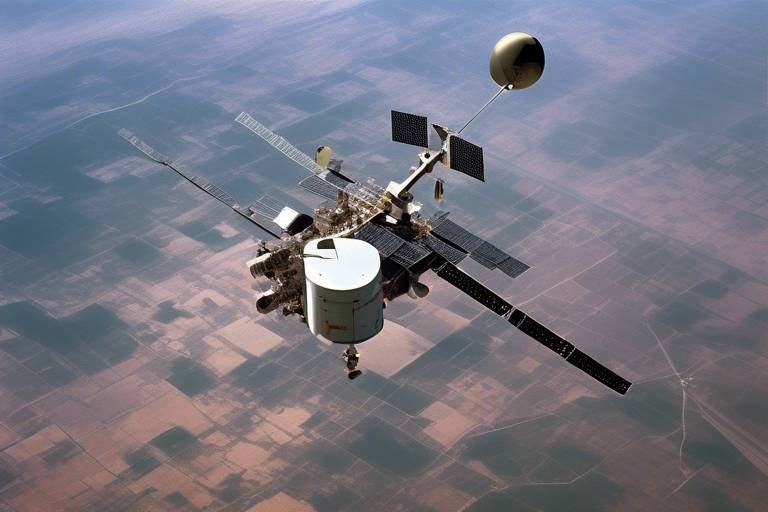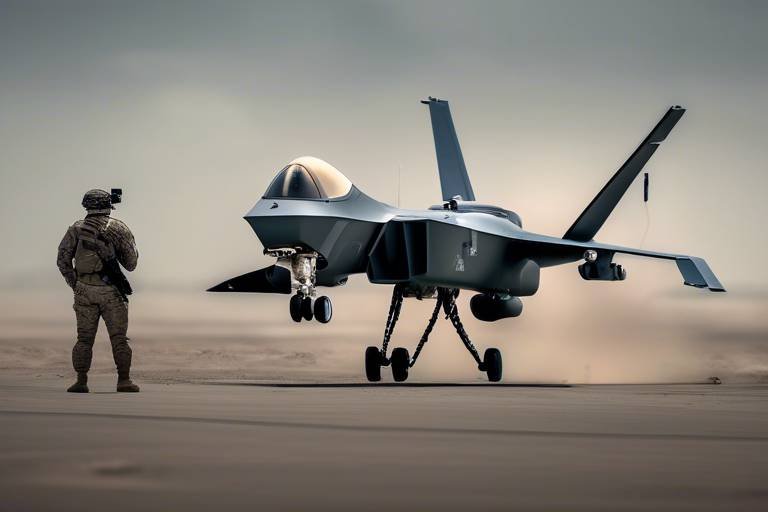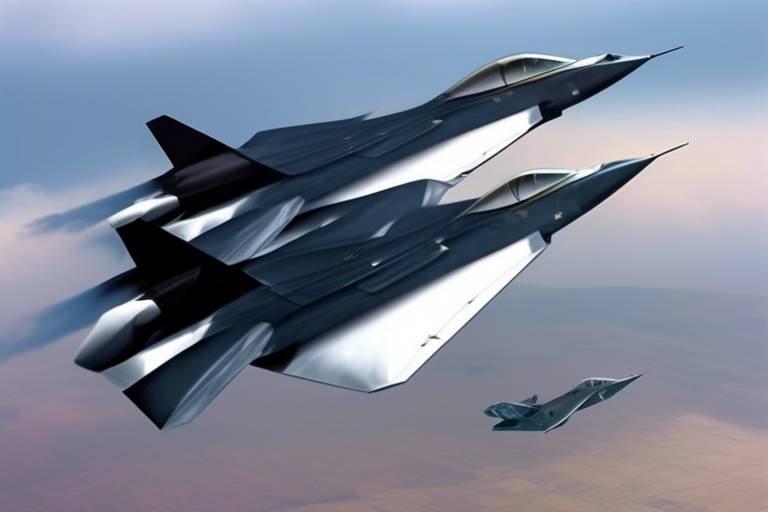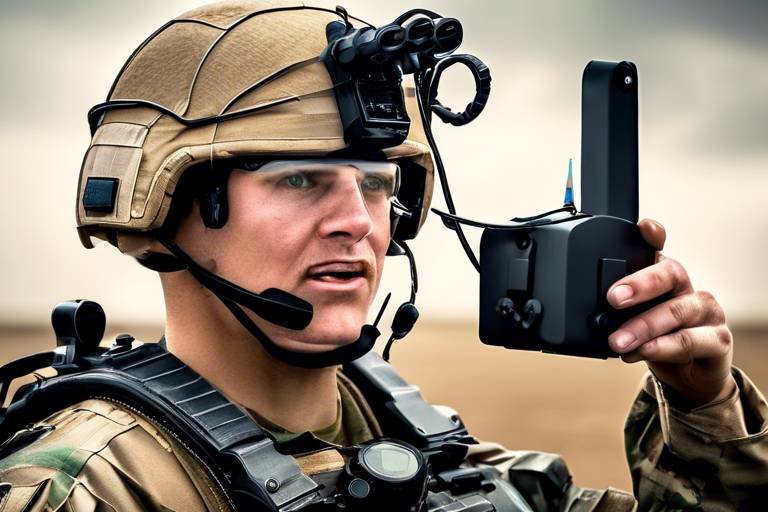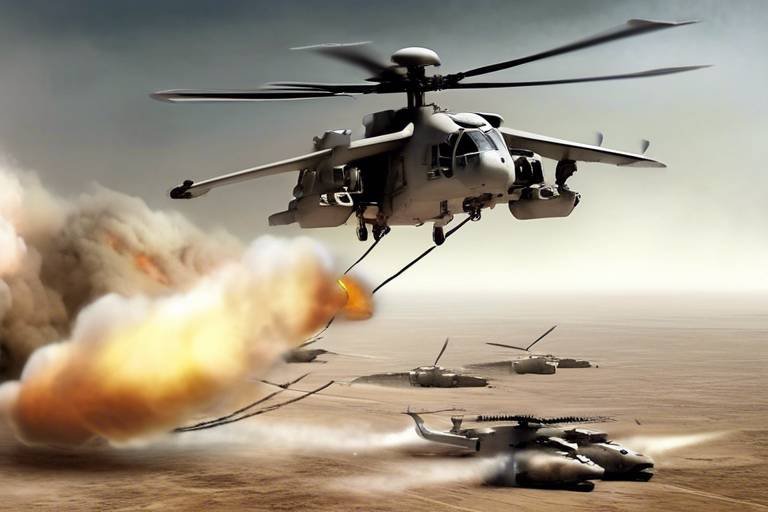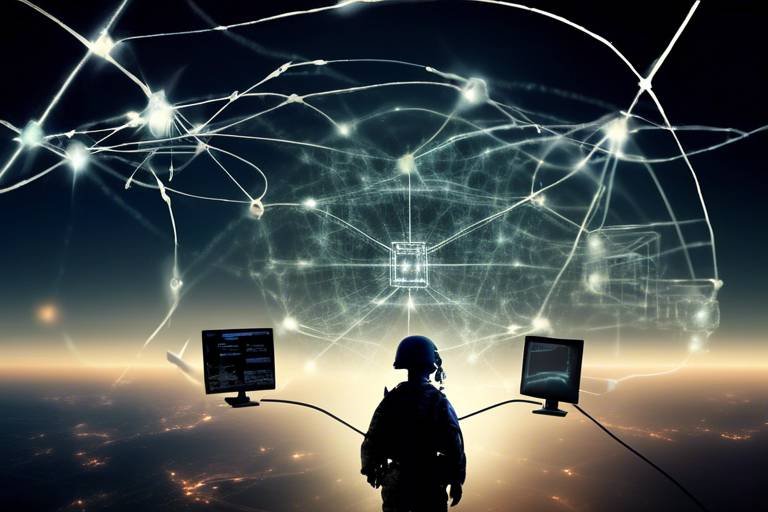Exploring the Potential of AI in Military Planning
In today’s rapidly evolving world, the integration of artificial intelligence (AI) into military planning is not just a trend; it’s a revolution. Imagine a battlefield where decisions are made not just by human intellect but by advanced algorithms that can analyze data faster than any human can comprehend. This article delves into the transformative impact of AI on military strategies, operations, and decision-making processes, highlighting its potential benefits and challenges in modern warfare.
The military landscape is changing, and with it, the tools used to navigate complex scenarios. AI is at the forefront of this change, offering capabilities that enhance efficiency and effectiveness in strategic planning. From predictive analytics that foresee potential threats to automated systems that monitor vast territories, AI is reshaping how military leaders strategize and execute operations. But what does this mean for the future of warfare? Is it a path toward greater security or a slippery slope fraught with ethical dilemmas? Let’s explore this fascinating intersection of technology and military strategy.
AI enhances strategic decision-making by providing data-driven insights, predictive analytics, and simulations. This technology enables military leaders to make informed choices and optimize resource allocation during critical operations. Imagine being able to simulate various combat scenarios in real-time, adjusting strategies based on the latest data inputs. This is not science fiction; it’s the current and future reality of military planning.
One of the most significant advantages of AI is its ability to process vast amounts of information quickly. Military organizations can leverage AI for data analysis, identifying patterns and trends that inform tactical decisions and improve operational efficiency. For instance, AI can sift through intelligence reports, satellite imagery, and communication intercepts to highlight crucial insights that human analysts might overlook.
AI technologies facilitate real-time intelligence gathering through advanced surveillance systems. These systems enhance situational awareness and enable timely responses to emerging threats on the battlefield. Imagine a scenario where drones equipped with AI can autonomously scan an area for potential threats, relaying critical information back to command centers without human intervention. This capability dramatically shortens the decision-making cycle and increases the chances of successful operations.
Automated surveillance systems powered by AI can monitor vast areas continuously, reducing the need for human operators. This not only saves resources but also provides critical information without the risk of fatigue or oversight. These systems can operate day and night, in various weather conditions, ensuring that military forces have a constant eye on the battlefield.
By utilizing predictive analytics, military planners can anticipate potential threats and adjust strategies accordingly. This proactive approach improves readiness and response times in dynamic combat environments. For example, if AI systems detect unusual troop movements or communications patterns, military leaders can be alerted to possible hostile actions before they escalate.
AI optimizes logistics and supply chain management in military operations, ensuring timely delivery of supplies and equipment while minimizing costs and maximizing efficiency. In a world where every second counts, the ability to predict supply needs and streamline delivery processes can make a significant difference in operational success. AI can analyze historical data, current inventory levels, and projected needs to create efficient supply routes and schedules.
Despite its potential, integrating AI into military planning poses challenges. Ethical concerns, data security issues, and the need for robust training programs are just a few hurdles that must be addressed. As we embrace this technology, we must also consider the implications of its use in warfare.
The use of AI in warfare raises ethical questions regarding accountability, decision-making autonomy, and the potential for unintended consequences in combat scenarios. For instance, if an AI system makes a decision that results in civilian casualties, who is held accountable? These are critical discussions that military leaders and policymakers must engage in as they navigate the complexities of AI integration.
Implementing AI systems requires stringent data security measures to protect sensitive information from cyber threats. As military operations become increasingly reliant on digital technologies, ensuring that these systems remain secure is paramount. A breach could compromise not only operational effectiveness but also national security.
- What are the primary benefits of AI in military planning? AI enhances decision-making, improves logistics, and provides real-time intelligence, making military operations more efficient.
- What ethical concerns are associated with AI in warfare? Ethical concerns include accountability for decisions made by AI, potential for misuse, and the risk of unintended consequences.
- How does AI improve logistics in military operations? AI optimizes supply chain management by predicting needs and streamlining delivery processes, ensuring timely access to necessary resources.
- What measures are taken to ensure data security in AI systems? Military organizations implement stringent security protocols and continuously monitor for cyber threats to protect sensitive information.

The Role of AI in Strategic Decision-Making
In today's fast-paced world, the military landscape is constantly evolving, and artificial intelligence (AI) is emerging as a game-changer in strategic decision-making. Imagine a scenario where military leaders can make informed choices based on real-time data and predictive analytics, much like a chess player anticipating their opponent's moves. This is the reality AI brings to the table, enabling a level of insight and foresight that was previously unimaginable. By harnessing the power of data-driven insights, military strategists can optimize resource allocation during critical operations, ensuring they are always one step ahead of potential threats.
One of the most significant advantages of AI in strategic decision-making is its ability to process vast amounts of information quickly. With the sheer volume of data generated in military operations, traditional methods of analysis simply can't keep up. AI algorithms can sift through this data, identifying patterns and trends that inform tactical decisions. For example, by analyzing historical conflict data, AI can help predict potential hotspots for future engagements, allowing military planners to allocate resources more effectively. It's like having a crystal ball that provides clarity in the chaos of warfare.
Furthermore, the integration of AI into strategic decision-making processes enhances the speed and accuracy of military operations. Consider a situation where a military unit is faced with a rapidly changing battlefield environment. AI systems can simulate various scenarios, providing commanders with a range of potential outcomes based on different courses of action. This capability not only aids in making informed decisions but also boosts confidence among military leaders, knowing they have the best possible information at their fingertips.
However, it's essential to recognize that the role of AI in military decision-making is not without its challenges. As we embrace this technology, we must also navigate the ethical implications and ensure that human judgment remains at the forefront. After all, while AI can provide valuable insights, the final decisions must still reflect the values and principles that govern our military operations. Striking a balance between leveraging AI's capabilities and maintaining human oversight is crucial for responsible military planning.
In summary, the role of AI in strategic decision-making is transformative, offering military leaders unprecedented access to data-driven insights and predictive analytics. As we continue to explore the potential of AI in military contexts, we must remain vigilant about the ethical considerations and ensure that technology serves to enhance, rather than replace, human judgment. The future of military strategy is undoubtedly intertwined with AI, and understanding this relationship will be key to navigating the complexities of modern warfare.
- How does AI improve decision-making in military operations?
AI enhances decision-making by providing data-driven insights, predictive analytics, and simulations that allow military leaders to make informed choices. - What are the ethical concerns surrounding AI in warfare?
The use of AI raises questions about accountability, decision-making autonomy, and the potential for unintended consequences in combat scenarios. - Can AI completely replace human decision-making in the military?
No, AI is a tool that provides valuable insights, but human judgment remains essential in making final decisions.

AI-Driven Data Analysis in Military Operations
In the fast-paced world of military operations, data is king. The ability to sift through mountains of information and extract actionable insights can mean the difference between success and failure on the battlefield. This is where artificial intelligence (AI) steps in, revolutionizing how military organizations approach data analysis. By leveraging advanced algorithms and machine learning techniques, AI can process vast amounts of data at lightning speed, identifying patterns and trends that would be impossible for human analysts to discern in a timely manner. Imagine having a supercharged assistant that never tires, never overlooks critical details, and can analyze data from multiple sources simultaneously—this is the potential of AI in military operations.
AI-driven data analysis allows military planners to make informed tactical decisions based on real-time data. For example, during a conflict, AI can analyze intelligence reports, satellite imagery, and social media feeds to provide a comprehensive picture of the battlefield. This capability enhances situational awareness, enabling commanders to respond swiftly to emerging threats. Moreover, the integration of AI into military operations can help in optimizing resource allocation, ensuring that troops are deployed where they are needed most, and that supplies are delivered in a timely manner.
Consider the following key benefits of AI in military data analysis:
- Speed: AI can analyze data far more quickly than human analysts, allowing for faster decision-making.
- Accuracy: With machine learning, AI systems can improve their accuracy over time, reducing the likelihood of errors in data interpretation.
- Scalability: AI systems can handle vast quantities of data from various sources, scaling to meet the demands of any operational scenario.
Furthermore, AI can enhance predictive capabilities, enabling military planners to foresee potential threats before they materialize. By analyzing historical data and current trends, AI can help identify patterns that may indicate an impending attack or a shift in enemy tactics. This foresight is invaluable, allowing military leaders to adjust their strategies proactively rather than reactively. For instance, if AI detects a sudden increase in troop movements in a specific area, it can alert commanders to investigate further, potentially thwarting an adversary's plans.
However, the integration of AI into military data analysis is not without its challenges. The reliance on algorithms raises questions about data quality and bias. If the data fed into AI systems is flawed or biased, the insights generated can lead to poor decision-making. Therefore, it is crucial for military organizations to ensure that their data is accurate, representative, and free from bias to maintain the integrity of AI-driven analyses. Additionally, training personnel to work effectively with AI tools is essential; they must understand not only how to use these tools but also how to interpret the insights they provide.
In conclusion, AI-driven data analysis is transforming military operations by enhancing speed, accuracy, and predictive capabilities. As military organizations continue to embrace this technology, the potential for improved decision-making and operational efficiency will only grow. However, it is imperative to address the challenges associated with data quality and personnel training to fully harness the power of AI in military contexts.
- What is AI-driven data analysis?
AI-driven data analysis refers to the use of artificial intelligence technologies to process and analyze large volumes of data, extracting valuable insights to inform decision-making.
- How does AI improve military operations?
AI improves military operations by enhancing data analysis, providing real-time intelligence, optimizing logistics, and enabling predictive capabilities that inform strategic decisions.
- What are the risks of using AI in military contexts?
The risks include data quality issues, potential biases in AI algorithms, and ethical concerns regarding accountability and decision-making autonomy.
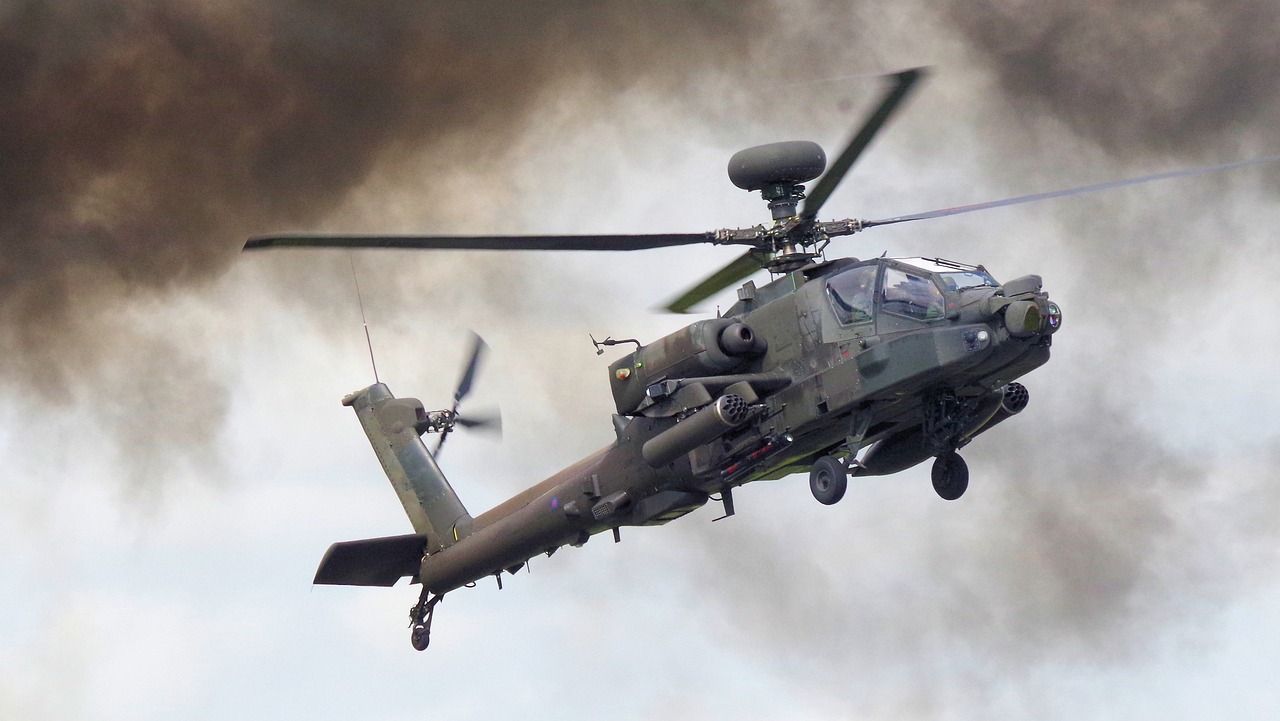
Real-Time Intelligence Gathering
In the fast-paced world of modern warfare, is akin to having a crystal ball that reveals the ever-changing battlefield landscape. Imagine being able to see the enemy's movements and strategies as they unfold, much like a chess player anticipating their opponent's next move. This is where artificial intelligence (AI) strides in, revolutionizing how military forces collect and analyze information. With advanced surveillance systems powered by AI, military organizations can monitor vast areas continuously, providing a level of situational awareness that was previously unimaginable.
One of the most significant advantages of AI in intelligence gathering is its ability to process and analyze data at lightning speed. Traditional methods often rely on human operators who can suffer from fatigue and oversight, leading to potential gaps in intelligence. However, with AI-driven systems, the risk of human error diminishes significantly. These systems can sift through mountains of data—from satellite imagery to social media feeds—identifying crucial patterns and insights in real-time. For instance, AI can detect unusual troop movements or changes in supply routes, alerting commanders to potential threats before they escalate.
Furthermore, the integration of AI in intelligence operations enables military forces to respond quickly to emerging threats. By utilizing machine learning algorithms, these systems can continually learn from new data, refining their predictions and enhancing their effectiveness. This is not just about gathering data; it's about transforming that data into actionable intelligence. Imagine a scenario where a drone equipped with AI technology can autonomously identify and track enemy positions while simultaneously relaying that information to ground troops. This level of coordination and speed is essential in today's combat environments, where seconds can mean the difference between success and failure.
Moreover, the implementation of AI in real-time intelligence gathering is not without its challenges. The technology must be continuously updated and maintained to ensure accuracy and reliability. Additionally, ethical considerations arise, particularly concerning privacy and the potential for misuse of surveillance data. As military organizations embrace AI, they must also navigate these complexities to ensure that their operations remain not only effective but also responsible.
In summary, real-time intelligence gathering powered by AI is transforming military operations. By enhancing situational awareness, reducing human error, and enabling rapid responses to threats, AI is paving the way for a new era of warfare. As this technology continues to evolve, it will undoubtedly play a crucial role in shaping the future of military strategy and operations.
- What is real-time intelligence gathering?
Real-time intelligence gathering refers to the immediate collection and analysis of information during military operations, allowing for quick decision-making and strategic adjustments.
- How does AI improve intelligence gathering?
AI enhances intelligence gathering by analyzing data faster and more accurately than human operators, identifying patterns, and providing actionable insights in real-time.
- What are the ethical concerns related to AI in military intelligence?
Ethical concerns include issues of privacy, accountability for decisions made by AI systems, and the potential for misuse of surveillance data.
- Can AI replace human intelligence analysts?
While AI can significantly augment the capabilities of human analysts, it is unlikely to completely replace them. Human judgment and contextual understanding remain vital in interpreting complex situations.

Automated Surveillance Systems
In the rapidly evolving landscape of modern warfare, have emerged as a game-changer, fundamentally altering how military operations are conducted. These systems, powered by advanced artificial intelligence, are designed to continuously monitor vast areas, providing real-time data that is crucial for decision-making on the battlefield. Imagine having an eye in the sky that never blinks—this is the essence of automated surveillance. With the ability to analyze and interpret data faster than any human could, these systems enhance situational awareness and ensure that military leaders have the most up-to-date information at their fingertips.
One of the most significant advantages of automated surveillance systems is their capacity to operate without the risk of fatigue or oversight that human operators face. Traditional surveillance methods often rely on personnel who can only maintain focus for so long. In contrast, AI-driven systems can monitor multiple feeds simultaneously, identifying potential threats or unusual activities with remarkable precision. This capability not only reduces the burden on human operators but also increases the overall effectiveness of surveillance operations.
Furthermore, these systems utilize a variety of technologies, including drones, satellites, and ground-based sensors, to gather data from diverse sources. For instance, drones equipped with high-definition cameras can cover large areas quickly, relaying critical information back to command centers in real-time. The integration of machine learning algorithms allows these systems to learn from past data, improving their threat detection capabilities over time. Here’s a breakdown of how automated surveillance systems operate:
| Technology | Functionality |
|---|---|
| Drones | Provide aerial surveillance and reconnaissance, capturing high-resolution images and videos. |
| Satellites | Monitor large geographical areas, offering insights into enemy movements and environmental changes. |
| Ground Sensors | Detect movement and activity on the ground, alerting personnel to potential threats. |
However, while the benefits of automated surveillance systems are clear, they are not without challenges. Issues such as data overload can arise, where the sheer volume of information generated can overwhelm analysts. Moreover, there are ethical considerations regarding privacy and the potential for misuse of surveillance data. As military organizations continue to explore the capabilities of these systems, it will be crucial to establish guidelines that ensure they are used responsibly and effectively.
In conclusion, automated surveillance systems represent a significant leap forward in military technology. By harnessing the power of artificial intelligence, these systems provide unparalleled support in monitoring and assessing threats, ultimately enhancing operational effectiveness. As technology continues to advance, the integration of these systems into military strategy will likely become even more pronounced, paving the way for a new era of warfare.
- What are automated surveillance systems? Automated surveillance systems are AI-powered technologies that continuously monitor areas to gather real-time data for military operations.
- How do these systems enhance military operations? They provide critical real-time information, reduce the risk of human error, and improve situational awareness on the battlefield.
- What technologies are used in automated surveillance? Technologies include drones, satellites, and ground-based sensors, all of which work together to provide comprehensive surveillance capabilities.
- Are there ethical concerns associated with automated surveillance? Yes, there are concerns regarding privacy, data overload, and the potential misuse of surveillance information.

Predictive Analytics for Threat Assessment
In today's fast-paced military landscape, predictive analytics stands out as a game-changer for threat assessment. Imagine having the ability to foresee potential risks before they materialize; that's the power of AI-driven predictive models. By analyzing historical data, real-time intelligence, and various environmental factors, military planners can create robust forecasts that inform strategic decisions. This proactive approach not only enhances readiness but also significantly improves response times in dynamic combat environments.
The process begins with data collection from multiple sources, such as satellite imagery, reconnaissance reports, and social media feeds. Once this data is gathered, AI algorithms sift through it, identifying patterns and anomalies that might indicate emerging threats. For instance, if a particular region shows a spike in troop movements or unusual communications, predictive analytics can flag this as a potential area of concern. This is akin to a weather forecast predicting a storm; by recognizing the signs early, military leaders can prepare and adapt their strategies accordingly.
Furthermore, predictive analytics can also be integrated with machine learning techniques, allowing systems to learn and evolve over time. This means that the more data these systems process, the more accurate their predictions become. Imagine a radar system that not only detects enemy aircraft but also predicts their flight paths based on historical engagement patterns; this level of insight can be invaluable in planning defensive maneuvers or offensive strikes.
However, it's essential to understand that predictive analytics is not infallible. While it provides valuable insights, it is crucial for military leaders to combine these analytics with human judgment and expertise. After all, data is only as good as the context in which it is interpreted. Therefore, ongoing training and collaboration between AI systems and military personnel are vital to harness the full potential of predictive analytics.
In summary, the integration of predictive analytics into military threat assessment represents a significant leap forward in operational effectiveness. By leveraging advanced data analysis, military organizations can not only anticipate threats but also strategically position themselves to counteract them, ensuring a higher level of preparedness in an ever-evolving battlefield.
- What is predictive analytics in military planning?
Predictive analytics involves using historical data and AI algorithms to forecast potential threats and inform strategic decisions in military operations. - How does AI improve threat assessment?
AI enhances threat assessment by quickly analyzing vast amounts of data, identifying patterns, and providing actionable insights that help military planners respond effectively to emerging threats. - Can predictive analytics eliminate risks in military operations?
While predictive analytics significantly improves threat awareness and response times, it cannot eliminate risks entirely. Human judgment and expertise remain essential in interpreting data and making informed decisions. - What are the limitations of predictive analytics?
Limitations include the reliance on data quality, the potential for misinterpretation, and the need for ongoing training to ensure effective use of AI technologies in military contexts.
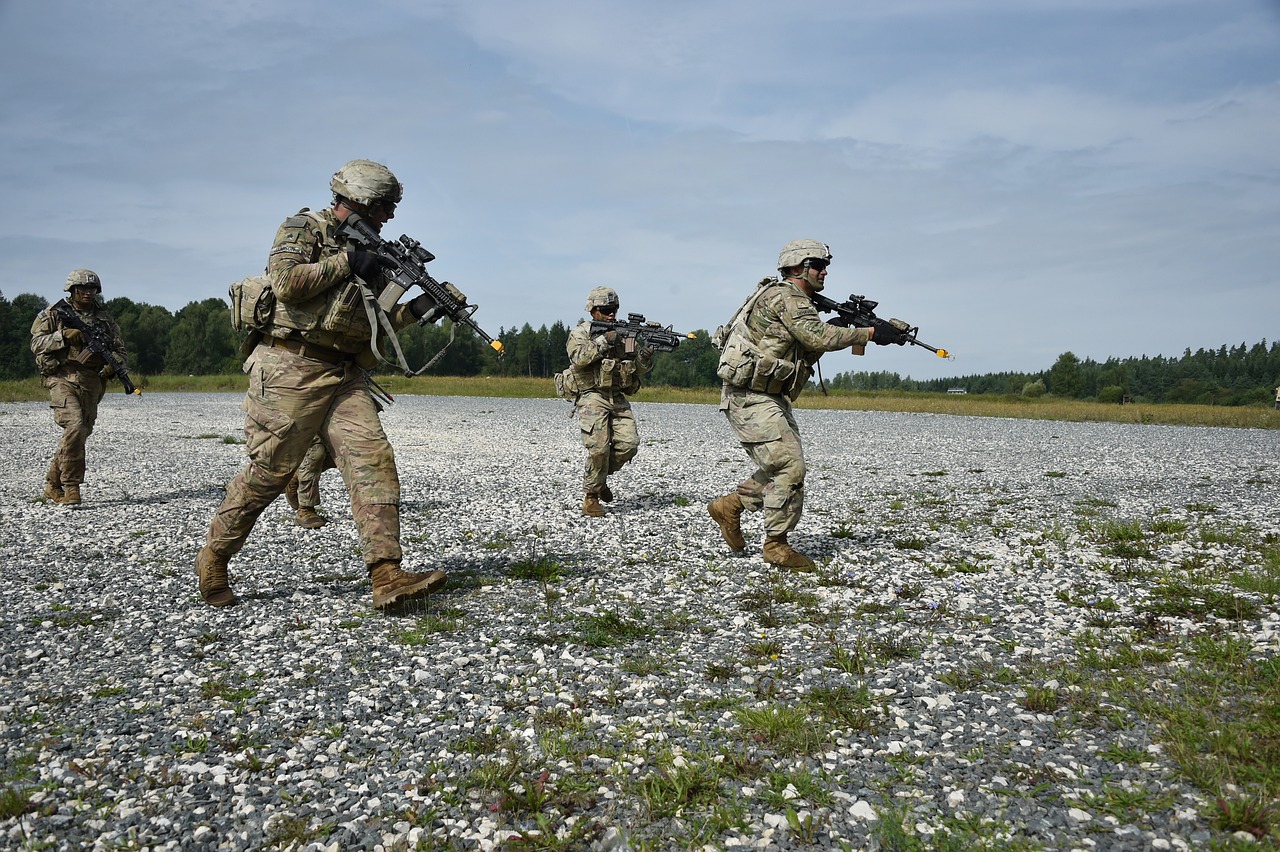
AI in Logistics and Supply Chain Management
In the complex world of military operations, logistics and supply chain management play a crucial role in ensuring that troops have the necessary resources to succeed. With the advent of artificial intelligence (AI), military logistics is undergoing a significant transformation, enhancing efficiency and effectiveness in ways previously thought impossible. Imagine a scenario where every supply route is optimized in real-time, where delays are anticipated and mitigated before they can impact operations. This is the power of AI in logistics.
AI systems can analyze vast amounts of data—from weather patterns to traffic conditions—allowing military planners to make informed decisions about supply routes and delivery schedules. By predicting potential disruptions, AI can help ensure that supplies arrive just in time, avoiding both shortages and excess inventory. For instance, an AI-driven logistics platform might use historical data to forecast the demand for essential supplies, such as ammunition or medical equipment, during specific operations, thereby streamlining the supply chain.
Furthermore, AI can automate many logistical tasks, reducing the burden on human operators and allowing them to focus on more strategic responsibilities. Automated systems can track inventory levels, manage warehouse operations, and even coordinate transportation logistics. This not only speeds up the process but also minimizes the risk of human error. In a military context, where every second counts, the ability to automate routine tasks can be a game changer.
| AI Applications in Military Logistics | Benefits |
|---|---|
| Predictive Analytics | Anticipates supply needs and optimizes resource allocation. |
| Automated Inventory Management | Reduces human error and enhances efficiency in tracking supplies. |
| Route Optimization | Ensures timely delivery by analyzing real-time data for the best routes. |
| Demand Forecasting | Improves readiness by predicting future supply needs based on historical data. |
However, the integration of AI in logistics is not without its challenges. One major concern is the reliance on technology, which can be problematic in environments where connectivity is limited. Additionally, the implementation of AI systems requires significant investment in infrastructure and training. Military personnel must be equipped with the skills to operate these advanced systems effectively, ensuring that they can leverage AI's full potential.
In conclusion, while the journey towards fully integrating AI in military logistics and supply chain management is fraught with challenges, the potential benefits are immense. By harnessing the power of AI, military organizations can ensure that their operations run smoothly, efficiently, and effectively, ultimately enhancing their operational readiness in an increasingly complex battlefield.
- What is the role of AI in military logistics? AI enhances logistical operations by optimizing supply routes, predicting demand, and automating inventory management.
- How does AI improve efficiency in military operations? By analyzing data in real-time, AI helps military planners make informed decisions, ensuring timely delivery of supplies and reducing delays.
- What challenges does AI face in military logistics? Key challenges include reliance on technology in low-connectivity areas, the need for significant investment, and the requirement for specialized training for personnel.

Challenges of Implementing AI in Military Contexts
As we dive deeper into the realm of artificial intelligence (AI) in military contexts, it's essential to recognize that while AI presents a plethora of opportunities, it also brings forth a myriad of challenges that cannot be overlooked. One of the most pressing concerns is the ethical implications surrounding the use of AI in warfare. Imagine a scenario where a machine makes life-and-death decisions without human intervention. This raises significant questions about accountability. Who is responsible if an AI system miscalculates a threat and causes unintended harm? The blurred lines of decision-making autonomy become a hotbed for debate among military strategists, ethicists, and lawmakers alike.
Moreover, the potential for unintended consequences in combat scenarios is alarming. AI systems, while sophisticated, may lack the nuanced understanding of human emotions and ethical considerations that are critical in warfare. For instance, a drone programmed to engage targets based on specific criteria could misinterpret a civilian gathering as a threat, leading to catastrophic outcomes. This highlights the necessity for stringent ethical guidelines and oversight in the deployment of AI technologies in military operations.
Another significant challenge is data security and privacy concerns. With the increasing reliance on AI systems, military organizations must ensure that sensitive information is protected from cyber threats. The digital age has made it easier for adversaries to infiltrate systems, and a breach could compromise not only military operations but also national security. To mitigate these risks, robust cybersecurity measures must be implemented, including encryption, secure communication channels, and regular audits of AI systems. The table below outlines some key strategies for enhancing data security in military AI applications:
| Strategy | Description |
|---|---|
| Encryption | Utilizing advanced encryption techniques to protect sensitive data from unauthorized access. |
| Access Control | Implementing strict access controls to ensure that only authorized personnel can interact with AI systems. |
| Regular Audits | Conducting regular audits of AI systems to identify vulnerabilities and ensure compliance with security protocols. |
Furthermore, the integration of AI technologies necessitates a comprehensive training program for military personnel. The complexity of AI systems means that operators must be well-versed in both the technology and its implications. Without proper training, the risk of misuse or misinterpretation increases, potentially leading to disastrous outcomes on the battlefield. This training should encompass not only technical skills but also ethical considerations and crisis management, ensuring that military personnel are equipped to handle AI systems responsibly.
In summary, while the potential benefits of AI in military planning are immense, the challenges it presents cannot be ignored. Ethical dilemmas, data security, and the need for effective training programs are critical issues that must be addressed to harness AI's full potential safely and responsibly. The military must tread carefully, balancing innovation with caution to ensure that AI serves as a tool for peace and security rather than a catalyst for conflict.
- What are the primary ethical concerns regarding AI in military applications? The main concerns include accountability for decisions made by AI, the potential for unintended harm, and the moral implications of autonomous warfare.
- How can military organizations ensure data security when using AI? Implementing encryption, access control, and regular audits can significantly enhance data security in military AI applications.
- Why is training important for military personnel using AI? Proper training ensures that personnel understand both the technical aspects of AI systems and the ethical considerations involved, reducing the risk of misuse.

Ethical Implications of AI in Warfare
As we delve deeper into the integration of artificial intelligence (AI) within military operations, it becomes increasingly crucial to address the ethical implications that accompany this technological revolution. The deployment of AI in warfare isn’t just about enhancing efficiency or improving outcomes; it raises profound questions about accountability, autonomy, and the very nature of combat itself.
One of the most pressing concerns is the issue of accountability. When AI systems make decisions on the battlefield, who is responsible for those decisions? If an autonomous drone mistakenly targets civilians, can we hold the developers, military leaders, or the AI itself accountable? This ambiguity can lead to a slippery slope where ethical lines are blurred, and the human element of responsibility is diminished.
Moreover, the autonomy granted to AI systems poses another ethical dilemma. As machines begin to take on roles traditionally held by humans, such as determining when to engage in lethal force, we must ask ourselves: should we allow machines to make life-and-death decisions? The potential for an AI to misinterpret a situation or malfunction could have catastrophic consequences. This raises the question of whether there should always be a human in the loop, ensuring that critical decisions are made with human judgment and empathy.
Additionally, the use of AI in warfare can lead to unintended consequences. Algorithms may inadvertently perpetuate biases present in their training data, leading to discriminatory targeting or misidentification of threats. The lack of transparency in how AI systems operate can further complicate matters, making it difficult to understand the rationale behind their decisions. This opacity can erode trust among military personnel and the public, highlighting the need for rigorous testing and validation of AI systems before deployment.
To navigate these complex ethical waters, military organizations must develop comprehensive frameworks that address these concerns. This includes:
- Establishing clear accountability measures for AI-driven decisions.
- Implementing robust oversight mechanisms to ensure human involvement in critical decision-making processes.
- Conducting thorough assessments of AI systems to identify and mitigate biases.
- Promoting transparency in AI operations to build trust among stakeholders.
In conclusion, while AI holds immense potential to transform military operations, it is imperative to approach its integration with caution and foresight. By addressing the ethical implications head-on, we can harness the benefits of AI while safeguarding the core values that define our humanity, even in the most challenging of circumstances.
- What are the main ethical concerns regarding AI in warfare?
The primary concerns include accountability for decisions made by AI, the autonomy of AI systems in lethal situations, and the potential for unintended consequences due to biases in AI algorithms. - How can military organizations ensure accountability in AI decision-making?
Establishing clear accountability measures, including oversight mechanisms and maintaining human involvement in critical decisions, can help ensure accountability in AI-driven actions. - What role does transparency play in the use of AI in military operations?
Transparency is crucial for building trust among military personnel and the public, as it allows stakeholders to understand how AI systems operate and make decisions.

Data Security and Privacy Concerns
This article delves into the transformative impact of artificial intelligence on military strategies, operations, and decision-making processes, highlighting its potential benefits and challenges in modern warfare.
AI enhances strategic decision-making by providing data-driven insights, predictive analytics, and simulations, enabling military leaders to make informed choices and optimize resource allocation during critical operations.
Leveraging AI for data analysis allows military organizations to process vast amounts of information quickly, identifying patterns and trends that inform tactical decisions and improve operational efficiency.
AI technologies facilitate real-time intelligence gathering through advanced surveillance systems, enhancing situational awareness and enabling timely responses to emerging threats on the battlefield.
Automated surveillance systems powered by AI can monitor vast areas continuously, reducing the need for human operators and providing critical information without the risk of fatigue or oversight.
By utilizing predictive analytics, military planners can anticipate potential threats and adjust strategies accordingly, improving readiness and response times in dynamic combat environments.
AI optimizes logistics and supply chain management in military operations, ensuring timely delivery of supplies and equipment while minimizing costs and maximizing efficiency.
Despite its potential, integrating AI into military planning poses challenges, including ethical concerns, data security issues, and the need for robust training programs to ensure effective use of AI technologies.
The use of AI in warfare raises ethical questions regarding accountability, decision-making autonomy, and the potential for unintended consequences in combat scenarios.
Implementing AI systems in military contexts brings about significant . With the increasing reliance on AI for critical operations, safeguarding sensitive information becomes paramount. Military organizations must ensure that their AI systems are fortified against cyber threats that could compromise operational integrity. Imagine a scenario where enemy forces gain access to classified data due to a security breach; the ramifications could be catastrophic.
Moreover, the sheer volume of data processed by AI systems can lead to privacy issues. The collection and analysis of personal information, whether from soldiers or civilians, necessitate stringent protocols to protect individual rights. This is especially crucial in areas where military operations overlap with civilian populations. To address these challenges, military planners should consider the following:
- Robust Cybersecurity Measures: Implement advanced encryption and intrusion detection systems to protect sensitive data.
- Regular Security Audits: Conduct frequent assessments of AI systems to identify vulnerabilities and ensure compliance with security protocols.
- Data Minimization Practices: Limit the collection of personal data to what is strictly necessary for operational effectiveness.
In addition, establishing clear guidelines for data usage and sharing can help mitigate risks. Developing a culture of cyber awareness among military personnel is also essential. Just like soldiers are trained for combat, they must also be educated on the importance of data security in the digital age.
Ultimately, the balance between leveraging AI for military advantage and ensuring data security and privacy is delicate. It requires ongoing dialogue, investment in technology, and a commitment to ethical practices. As we stand on the brink of a new era in military strategy, how we navigate these challenges will shape the future of warfare.
The primary concerns include the vulnerability of AI systems to cyber attacks, the potential for data breaches, and the ethical implications of collecting and analyzing personal information.
By implementing robust cybersecurity measures, conducting regular security audits, and adhering to data minimization practices, military organizations can significantly enhance their data security posture.
Privacy concerns arise from the collection and processing of personal data, especially when military operations overlap with civilian populations. Protecting individual rights while utilizing AI is crucial.
Frequently Asked Questions
- What is the role of AI in military strategic decision-making?
AI plays a crucial role in military strategic decision-making by providing data-driven insights and predictive analytics. It helps military leaders make informed choices and optimize resource allocation during critical operations, ultimately enhancing the effectiveness of military strategies.
- How does AI improve data analysis in military operations?
AI enhances data analysis in military operations by quickly processing vast amounts of information. This capability allows military organizations to identify patterns and trends that inform tactical decisions, leading to improved operational efficiency and better outcomes on the battlefield.
- What are automated surveillance systems and how do they work?
Automated surveillance systems powered by AI continuously monitor large areas without human intervention. These systems provide critical information and enhance situational awareness, significantly reducing the risk of fatigue or oversight that can occur with human operators.
- Can AI help in predicting potential threats in military contexts?
Yes, AI can utilize predictive analytics to anticipate potential threats, allowing military planners to adjust their strategies accordingly. This proactive approach improves readiness and response times in dynamic combat environments, ensuring military forces are better prepared for emerging challenges.
- What are the logistics benefits of using AI in military operations?
AI optimizes logistics and supply chain management by ensuring the timely delivery of supplies and equipment. This not only minimizes costs but also maximizes efficiency, which is crucial for maintaining operational effectiveness in military missions.
- What challenges arise from implementing AI in military planning?
Implementing AI in military planning presents several challenges, including ethical concerns about accountability and decision-making autonomy, data security issues, and the need for robust training programs to ensure effective use of AI technologies in various military contexts.
- What ethical implications are associated with AI in warfare?
The use of AI in warfare raises ethical questions regarding accountability and the potential for unintended consequences in combat scenarios. These concerns necessitate careful consideration and guidelines to ensure responsible use of AI technologies in military operations.
- How can military organizations address data security concerns when using AI?
Military organizations can address data security concerns by implementing stringent security measures to protect sensitive information from cyber threats. Ensuring robust cybersecurity protocols is essential for maintaining the integrity and effectiveness of military operations in the digital age.





